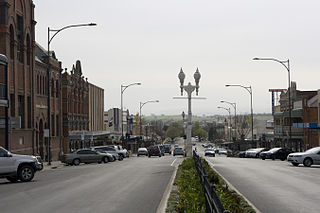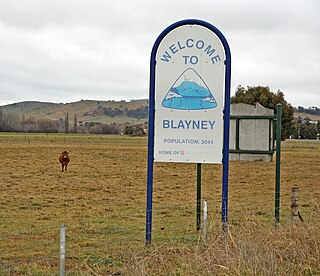Related Research Articles

Bathurst is a city in the Central Tablelands of New South Wales, Australia. Bathurst is about 200 kilometres (120 mi) west-northwest of Sydney and is the seat of the Bathurst Regional Council. Bathurst is the oldest inland settlement in Australia and had a population of 37,191 in June 2019.

Albert Bathurst Piddington KC was an Australian lawyer, politician and judge. He was a member of the High Court of Australia for one month in 1913, making him the shortest-serving judge in the court's history.

Blayney is a farming town and administrative centre with a population of 3,378 in 2016, in the Central West region of New South Wales, Australia. Situated on the Mid-Western Highway about 240 km (150 mi) west of Sydney, 35 km (22 mi) west of Bathurst and 863 m (944 yd) above sea-level, Blayney is the seat of Blayney Shire Council.

Bathurst is an electoral district of the Legislative Assembly in the Australian state of New South Wales. It is represented by Paul Toole of the Nationals.

John Hubert Plunkett was Attorney-General of New South Wales, an appointed member of the Legislative Council 1836–41, 1843–56, 1857–58 and 1861–69. He was also elected as a member of the Legislative Assembly 1856–60. He is best known for the prosecution of the colonists who brutally murdered 28 Aboriginals in the Myall Creek Massacre of 1838, seven of whom were convicted and hanged.

Cook Park is a heritage-listed 4-hectare (10-acre) urban park at 24-26 Summer Street, Orange, City of Orange, New South Wales, Australia. It was designed and built by Alfred Patterson from 1873 to 1950. It is also known as Orange Botanic Garden. It was added to the New South Wales State Heritage Register on 24 August 2018. The park's main entrance is from the corner of Summer Street and Clinton Street.
Joseph Backler was an English-born Australian painter. Transported to Australia as a convict in 1832, he obtained a ticket of leave in 1842 and was active as a painter from 1842 to 1880.

The Electoral district of County of Bathurst was an electorate of the New South Wales Legislative Council at a time when some of its members were elected and the balance were appointed by the Governor.
The 1856 New South Wales colonial election was to return 54 members of Legislative Assembly composed of 34 electoral districts with 18 returning 1 member, 13 returning 2 members, two returning 3 members and one returning 4 members, all with a first past the post system. In multi-member districts, because each voter could cast more than one vote, it is not possible to total the votes to show the number of voters and voter turnout in these districts is estimated. 8 members from 6 districts were returned unopposed.

William Richard Cortis was an English-born medical practitioner and politician in New South Wales, Australia.

Fergus Jago Smith was an Australian politician and pastoralist.
Lewis Lloyd was a Welsh-born Australian mining entrepreneur and politician.

Richard Jones was an Australian politician.
Francis Lord, often referred to as Frank Lord, was an Australian politician.

The Bentinck Street Elm Trees is a heritage-listed row of street trees at Bentinck Street, Bathurst, Bathurst Region, New South Wales, Australia. The property is owned by Bathurst Regional Council. It was added to the New South Wales State Heritage Register on 2 April 1999.

Blayney Uniting Church is a heritage-listed Uniting church at Adelaide Street, Blayney, Blayney Shire, New South Wales, Australia. The property is owned by the Uniting Church in Australia. It was added to the New South Wales State Heritage Register on 2 April 1999.
The 1843 New South Wales colonial election, the first in the colony, was held between 15 June and 3 July 1843, to elect 24 members from 18 electoral districts. Each district returned 1 member except for Port Phillip which returned 5 members while County of Cumberland, and Town of Sydney returned 2 each.
The 1848 New South Wales colonial election was held between 29 July and 2 August. No candidates were nominated for Port Phillip as a result of the campaign for independence from New South Wales, and a fresh writ was issued for an election on 3 October.
The Electoral district of Counties of Roxburgh, Phillip and Wellington and from 1851, Roxburgh and Wellington, was an electorate of the partially elected New South Wales Legislative Council, created for the first elections for the Council in 1843. The electoral district included the western counties of Roxburgh, Phillip, Wellington County. Polling took place at Montefiores, Mudgee, Bathurst and Hartley. The County of Phillip was removed from the district with the expansion of the Council in 1851 and became part of the Counties of Phillip, Brisbane and Bligh.

Alexander Green was an Australian executioner. He arrived in the colony of New South Wales in 1824 as a convict and was granted a Certificate of Freedom in 1831. During the period 1826 to late 1833 Green was employed as a flagellator, or scourger, at Sydney, Port Stephens and the Hunter Valley, inflicting floggings on those who had received a sentence of corporal punishment. In February 1834 he was appointed as the colony's public executioner, beginning a career of twenty-one years during which Green carried out about 250 hangings. During most of his employment as the New South Wales hangman, judicial executions were able to be viewed by the public. His last execution in February 1855 was the first private hanging after the enactment of legislation to abolish public executions in New South Wales. Towards the end of his career Green's behaviour became increasingly erratic due to drunkenness and mental instability. He was declared to be insane in April 1855 and committed to a lunatic asylum. Alexander Green died at the Parramatta Asylum on 31 August 1879.
References
- ↑ "Mr Richard Randolph Machattie (1843-1902)". Former members of the Parliament of New South Wales . Retrieved 16 June 2019.